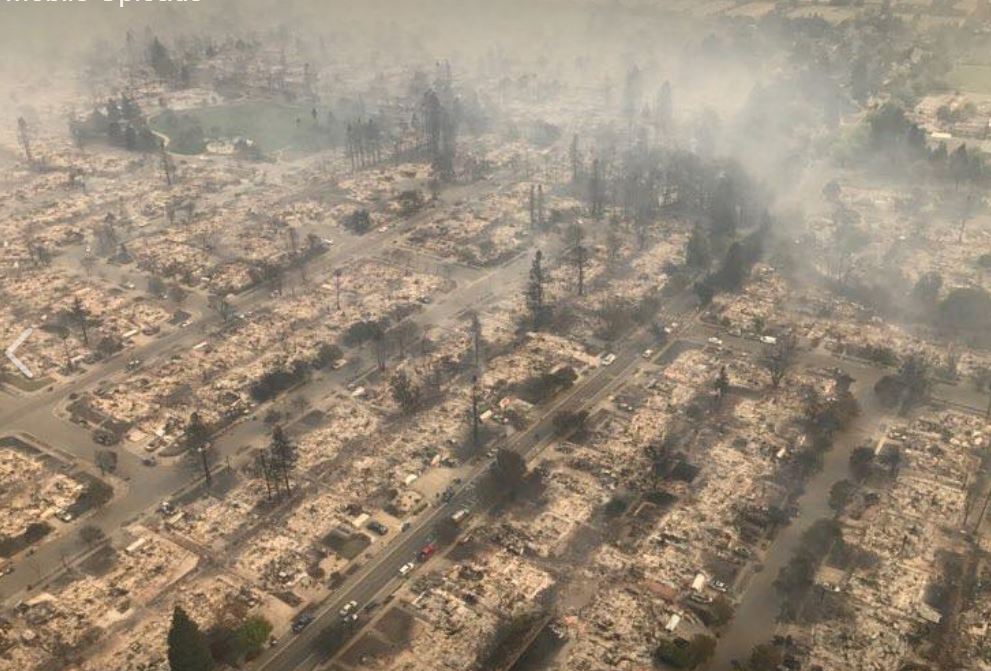
As California Burns, Trump Proposes to Rip Up Landmark Climate Laws
Later today the Trump Administration will propose ripping up climate legislation to save dirty coal jobs at the same time as California burns out of control from wildfires, made worse by climate change.
The irony could not be greater. Later today, a climate denying President will formally propose to repeal Barack Obama’s landmark climate legislation, the Clean Power Plan, which is designed to limite carbon dioxide from power plants and is a central part of the US commitment to reduce greenhouse gases under the Paris agreement,
Yesterday, the President’s climate denying head of the Environmental Protection Agency, Scott Pruitt, delighted an audience of miners when he said the law exceeded its powers and needed to be binned. He received raucous applause.
These two powerful men propose to rip up climate legislation to save dirty coal jobs at the same time as California burns out of control from wildfires, made worse by climate change. As miners cheer the Trump Administration, California mourns its dead.
The wine growing area of Northern California is currently in crisis. According to the LA Times, at least 10 people have died and at least 1,500 homes, businesses and other structures destroyed in over eight counties of the state, covering 73,000 acres. The city of Santa Rosa was surrounded by fire yesterday and last night was under curfew.
Yesterday, Governor Jerry Brown declared a state of emergency, with the wildfires seen as some of the worst in California’s history.
One Santa Rosa native, Jen Ancic, 31, fled with her two young sons. She told the LA Times that fires in the mountains were not uncommon, but “nothing like this has happened in Santa Rosa.”
Late yesterday, the Sonoma County Sheriff’s Office reported seven fire-related deaths. Sonoma County Supervisor Shirlee Zane said: “We are a resilient county; we will come back from this. But right now we need to grieve.”
Although the National Weather service say they expect some fires at this time of year, the extremely dry conditions exacerbated by California’s long drought, have made things much worse.
Amy Head, the fire captain spokesperson for Cal Fire, the state agency responsible for fire protection, told the Guardian “We often have multiple fires going on, but the majority of them all started right around same time period, same time of night – it’s unprecedented.”
She added that “I hate using that word because it’s been overused a lot lately because of how fires have been in the past few years, but it truly is – there’s just been a lot of destruction.”
Head told the paper that the fires were linked to climate change. “It has been hotter, it has been drier, our fire seasons have been longer, fires are burning more intensely, which is a direct correlation to the climate changing”.
Indeed, 2017 could be one of the worse fire seasons on record, even though this year was not meant to be a bad year for fires on the West Coast. This wasn’t supposed to be a bad year for Western wildfires. But California is not alone. Earlier this year over a million acres burned in Montana and other fires raged in Washington state and Oregon.
Park Williams is a research scientist at the Lamont-Doherty Earth Observatory at Columbia University. Last year he co-wrote a paper, published in Proceedings of the National Academy of Sciences, which concluded that the total area burned in the western US over the past 33 years was double the size it would have been without human-induced climate change.
Speaking to the Atlantic magazine last month, Williams called wildfires the “canary in the coal mine” for the effects of climate change. He said: “thinking about temperature trends due to human-caused climate change, we think that the western United States is 1.5 [degrees] Celsius, or 3 degrees Fahrenheit, hotter than it would be in absence of climate change … Because of the exponential influence of temperature, that means that this heat wave is having a way worse influence on fire than it would in absence of human-caused warming.”
“According to climate models, by the end of this century, the western United States is still projected to warm by about another 3.5 degrees Celsius,” says Williams. “And when we remember that the relationship between temperature and fire is exponential … we’re really talking about a very different western United States in 50 years.”
In the meantime, Trump wants us to carry on digging coal.

